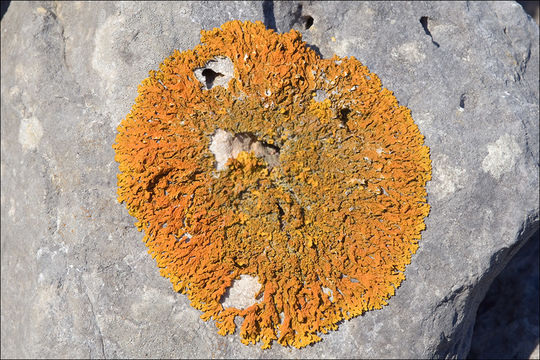Image of Xanthoria aureola (Ach.) Erichsen

Description:
Syn: Xanthoria ectaneoides (Nyl.) Zahlbr., Xanthoria parietina var. ectanea auct. brit, Parmelia aureola Ach., Physcia aureola (Ach.) Linds., Xanthoria parietina f. aureola (Ach.) P. Syd. - Habitat: dry stony wall delimiting (mostly) abandoned fields and deserted terraced olive groves; close to sea shore; almost flat terrain; calcareous, skeletal ground; dry place, full sun; exposed to direct rain, average precipitations ~ 900 mm/year, average temperature 12-14 deg C, elevations 35 m (110 feet), Sub-Mediterranean phytogeographical region. - Substratum: vertical to steeply inclined surface of limestone rocks, west-southwest exposition. - Comment: This was a beautiful and interesting find. The lichen is very conspicuous because of its deep orange color and considerable size. Several specimens were found in the vicinity. Also its taxonomy is interesting. After Smith (2009) it should be named Xanthoria aureola. However, this name has been long time used (and is still so by many) for another very similar specimen Xanthoria calcicola Oxner. Many (Ref.:2) would rather call them and also do so (Ref.:3) Xanthoria ectaneoides. They claim that the name Xanthoria aureola opposes the Article 57 of the International Code of Botanical Nomenclature. Other consider this species only as a 'kind of' very common Xanthoria parietina. The result is a considerable confusion in naming. Be that as it may Xanthoria calcicola differs from Xanthoria aureola by densely isidiate central part of the thallus (see Ref.: 7) and less strap-shaped and sparsely overlapping thallus terminal lobes (Smith 2009). Smith (2009) considers this species as Western European species and GBIF map confirms this by showing most of observations along west coasts from north Scandinavia to Canary Islands and with a few exceptions in Germany (a single specimen now in herbarium Berlin), on Crete and several finds in Italy (Ref.:6). Almost all finds are close to sea shores. What puzzles me with this observation is the center of the thallus on picture 2b, upper part. The thallus is 'bumpy' there and this bumps may eventually be interpreted as isidia. I am not sure. If so, this would not fit to Xanthoria aureola. Also, Smith lists ' siliceous or, rarely, basic rock ' as a most common substratum, while Dobson 2005 doesn't list siliceous rock as an option, but eventually allows basic rock. This find was surely found on calcareous, basic rock. The lichen was photographed in completely dry state. Ref.: (1) C.W.Smith, et all, The lichens of Great Britain and Ireland,The British Lichen Society,(2009), p 968. (2) http://www.lichens.lastdragon.org/Xanthoria_aureola.html (accessed April 3. 2018) (3) F.S. Dobson, Lichens, The Richmonds Publishing Ca.LTD (2005), p 462. (4) V. Wirth, Die Flechten Baden-Wrttembergs, Teil.2., Ulmer (1995), p 974. (5) https://www.gbif.org/species/2609974 (accessed April 3. 2018) (6) http://dbiodbs.univ.trieste.it/italic/italic41 (accessed April 3. 2018) (7) http://www.lichens.lastdragon.org/Xanthoria_calcicola.html (accessed April 4. 2018)
Included On The Following Pages:
- Life (creatures)
- Cellular (cellular organisms)
- Eukaryota (eukaryotes)
- Opisthokonta (opisthokonts)
- Nucletmycea
- Fungi (mushrooms, lichens, molds, yeasts and relatives)
- Dikarya
- Ascomycota (sac fungi)
- Lecanoromycetes
- Teloschistales
- Teloschistaceae
- Xanthoria aureola
This image is not featured in any collections.
Source Information
- license
- cc-by-nc-sa-3.0
- copyright
- 2018 Dr. Amadej Trnkoczy
- photographer
- Dr. Amadej Trnkoczy
- original
- original media file
- visit source
- partner site
- CalPhotos
- ID


